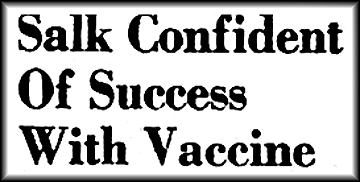Many people likely recall the 1952 polio epidemic that spread throughout the nation, paralyzing individuals and putting many in “iron lungs,” large machines used to control breathing. Several folks cancelled travel plans for fear of contracting the dreaded disease. Several vaccine tests, developed by Jonas Salk, were administered around the country with encouraging results.
On April 15, 1954, Washington County rolled out its trial vaccine program for city and county schools. To better inform the public, Dr. Emmett Byrd, director of the effort, prepared 25 questions and answers for the Johnson City Press-Chronicle. Here is a paraphrase of them:

Johnson City Press Chronicle Newspaper Clipping about the Polio Epidemic
1. What is the trial polio vaccine? A watery solution containing killed polio virus, which, hopefully, will stimulate the body to produce adequate antibodies in the blood to protect against paralytic polio.
2. Who will receive it? All second grade children in Washington County schools, city and county.
3. Why were these children selected? This group is more susceptible to getting polio.
4. Will any other children receive the trial vaccine? No.
5. What are the “control” groups? Children in the first and third grades from whom blood samples will be collected and compared with those who receive the vaccine.
6. Who will give the trial vaccine? Local physicians volunteering through the county in cooperation with local health authorities.
7. Where will the trial vaccine be given? At seventeen centers: seven in the county and ten in the city.
8. How many doses will be given each child? Three.
9. Can a child in a grade that is being tested take if he or she already has had polio. Yes, three types of polio virus are definitely known and immunity to one type does not protect the individual against the others.
10. Will a child receive the first dose if he or she is absent on the designated day? No. It is imperative to receive the first dose on the scheduled day.
11. What happens if a child misses school on the days that the second or third dose is given? It will be rescheduled at a later date.
12. What is the period between doses? One week between the first two and four weeks between the second and third. The last one is known as the booster shot.
13. Why are three separate doses necessary? The first two doses stimulate the body to produce antibodies while the third one boosts antibodies to a high level.
14. How much trial vaccine does each child receive? One cubic centimeter at each dose. Three shots collectively amount to 45 drops.
15. Where on the body is the trial vaccine administered? In the arm muscle.
16. Will it leave a scar or produce aftereffects? So far, none have been observed.
17. How can parents be certain the vaccine is safe? All lots of vaccine have been thoroughly tested by all means known to medical science.
18. Has the trial vaccine been used on human beings before? Yes, for over a year.
19. Will the child's family be charged for the trial? No.
20. Will all participating children be volunteers. Yes.
21. How will the parent of an eligible child request participation? By returning a signed request form to the school.
22. How will we know if the trial vaccine has protected the children? Late in 1955, results will be made known.
23. How long will the vaccine be effective? That information is not known at this time.
24. Will volunteer workers be needed for the vaccine trials? Yes, a great many for multiple non-medical tasks.
25. How many children in Washington county will be eligible to receive the trial vaccine? 592 second graders in city schools and 349 in county ones, a total of 941.
I was in the fifth grade at Henry Johnson School in the spring of 1954 and too old to participate in the program. By 1961, progress, which by then included Albert Sabin's oral polio vaccine, reduced the cases of the disease in the United State to 161. Doctors Salk and Sabin became household names. If you participated in the program, drop me a note.
